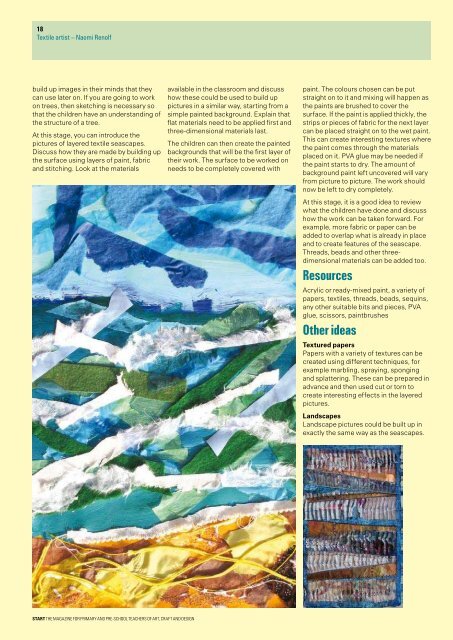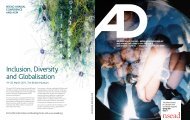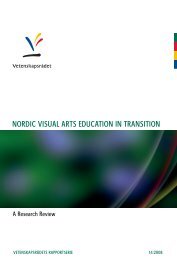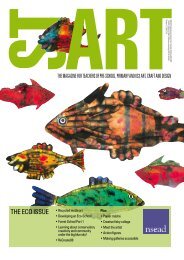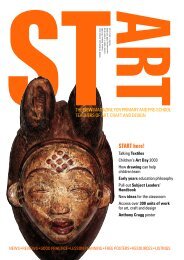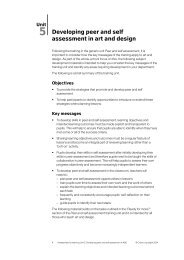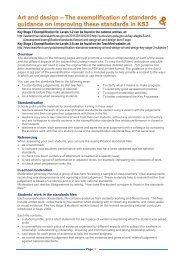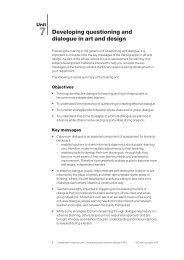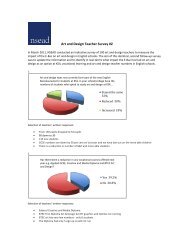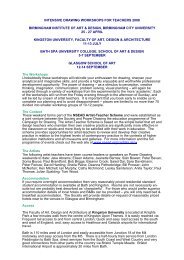textiles issue - The National Society for Education in Art and Design
textiles issue - The National Society for Education in Art and Design
textiles issue - The National Society for Education in Art and Design
You also want an ePaper? Increase the reach of your titles
YUMPU automatically turns print PDFs into web optimized ePapers that Google loves.
18Textile artist – Naomi Renolf19Early Yearsbuild up images <strong>in</strong> their m<strong>in</strong>ds that theycan use later on. If you are go<strong>in</strong>g to workon trees, then sketch<strong>in</strong>g is necessary sothat the children have an underst<strong>and</strong><strong>in</strong>g ofthe structure of a tree.At this stage, you can <strong>in</strong>troduce thepictures of layered textile seascapes.Discuss how they are made by build<strong>in</strong>g upthe surface us<strong>in</strong>g layers of pa<strong>in</strong>t, fabric<strong>and</strong> stitch<strong>in</strong>g. Look at the materialsavailable <strong>in</strong> the classroom <strong>and</strong> discusshow these could be used to build uppictures <strong>in</strong> a similar way, start<strong>in</strong>g from asimple pa<strong>in</strong>ted background. Expla<strong>in</strong> thatflat materials need to be applied first <strong>and</strong>three-dimensional materials last.<strong>The</strong> children can then create the pa<strong>in</strong>tedbackgrounds that will be the first layer oftheir work. <strong>The</strong> surface to be worked onneeds to be completely covered withpa<strong>in</strong>t. <strong>The</strong> colours chosen can be putstraight on to it <strong>and</strong> mix<strong>in</strong>g will happen asthe pa<strong>in</strong>ts are brushed to cover thesurface. If the pa<strong>in</strong>t is applied thickly, thestrips or pieces of fabric <strong>for</strong> the next layercan be placed straight on to the wet pa<strong>in</strong>t.This can create <strong>in</strong>terest<strong>in</strong>g textures wherethe pa<strong>in</strong>t comes through the materialsplaced on it. PVA glue may be needed ifthe pa<strong>in</strong>t starts to dry. <strong>The</strong> amount ofbackground pa<strong>in</strong>t left uncovered will varyfrom picture to picture. <strong>The</strong> work shouldnow be left to dry completely.At this stage, it is a good idea to reviewwhat the children have done <strong>and</strong> discusshow the work can be taken <strong>for</strong>ward. Forexample, more fabric or paper can beadded to overlap what is already <strong>in</strong> place<strong>and</strong> to create features of the seascape.Threads, beads <strong>and</strong> other threedimensionalmaterials can be added too.ResourcesAcrylic or ready-mixed pa<strong>in</strong>t, a variety ofpapers, <strong>textiles</strong>, threads, beads, sequ<strong>in</strong>s,any other suitable bits <strong>and</strong> pieces, PVAglue, scissors, pa<strong>in</strong>tbrushesOther ideasTextured papersPapers with a variety of textures can becreated us<strong>in</strong>g different techniques, <strong>for</strong>example marbl<strong>in</strong>g, spray<strong>in</strong>g, spong<strong>in</strong>g<strong>and</strong> splatter<strong>in</strong>g. <strong>The</strong>se can be prepared <strong>in</strong>advance <strong>and</strong> then used cut or torn tocreate <strong>in</strong>terest<strong>in</strong>g effects <strong>in</strong> the layeredpictures.L<strong>and</strong>scapesL<strong>and</strong>scape pictures could be built up <strong>in</strong>exactly the same way as the seascapes.<strong>The</strong> Magic Fish– an Early Years project that<strong>in</strong>spired work with KS2Sylwia Arneil, from St Aloysius RCPrimary School <strong>in</strong> Ox<strong>for</strong>d, describes a<strong>textiles</strong> project that was <strong>in</strong>itiallyundertaken with Year 1 pupils after read<strong>in</strong>gthe story <strong>The</strong> Magic Fish. It led to work <strong>in</strong>felt, with the school KS2 art club us<strong>in</strong>g thesame <strong>in</strong>spiration.Literacy start<strong>in</strong>g po<strong>in</strong>tIt all started with the story of <strong>The</strong> MagicFish, which I read to the children the otherday. <strong>The</strong> story was met with greatexcitement <strong>and</strong> <strong>in</strong>terest, perhaps becauseit was already known to the majority ofthem, or maybe because it had all thequalities of a classic tale. Many of thechildren started wonder<strong>in</strong>g what theymight wish <strong>for</strong> if they were lucky enough tocatch a magic fish, <strong>and</strong> perhaps what itmight look like. <strong>The</strong> discussion thatfollowed was full of ideas <strong>and</strong> descriptivelanguage – it looked as if the fish hadalready worked some of its magic <strong>in</strong> thechildren’s imag<strong>in</strong>ations!<strong>The</strong> Golden Fishby Paul KleePaul Klee, who was a great admirer ofchildren’s art, created <strong>in</strong> this pa<strong>in</strong>t<strong>in</strong>g a verysimply composed but richly detailedunderwater world. I showed the childrenthe pa<strong>in</strong>t<strong>in</strong>g <strong>in</strong> large scale on an <strong>in</strong>teractivewhiteboard, which was very helpful <strong>and</strong>made the session, with 27 children, mucheasier to run. <strong>The</strong> children could easily readthe picture, but needed to be helped <strong>and</strong>guided a little bit to notice <strong>and</strong> appreciatedetails like the variety of seaweed, thewaves, the air bubbles <strong>and</strong> the patterns onthe fish. Once prompted, they becameextremely absorbed <strong>in</strong> analys<strong>in</strong>g thepa<strong>in</strong>t<strong>in</strong>g <strong>and</strong> learned to observe <strong>and</strong>enquire beyond the obvious.need to use gold or silver pa<strong>in</strong>t – thecontrast between colours can make th<strong>in</strong>gsappear sh<strong>in</strong>y. <strong>The</strong> children found thisdiscussion very <strong>in</strong>terest<strong>in</strong>g <strong>and</strong> <strong>in</strong>spir<strong>in</strong>g<strong>and</strong> were ready to create their ownartwork.Oil pastel draw<strong>in</strong>gsI asked the children to draw their ownmagic fish on a piece of A4 paper. I h<strong>and</strong>edout the reproductions of Klee’s pa<strong>in</strong>t<strong>in</strong>g,expla<strong>in</strong><strong>in</strong>g that they could be used as asupport<strong>in</strong>g resource. I did not want thechildren to copy the pa<strong>in</strong>t<strong>in</strong>g, but to use itas an <strong>in</strong>spiration <strong>and</strong> also as a rem<strong>in</strong>der ofwhat a f<strong>in</strong>ished picture should look like, asfive-year-olds tend to sketch rather thanstudy. Prior to this, we discussed thetechnical details of us<strong>in</strong>g oil pastel: thedifferent mark-mak<strong>in</strong>g that can beachieved, depend<strong>in</strong>g on the position of thepastel, blend<strong>in</strong>g to mix colours, <strong>and</strong> so on.Some children found the draw<strong>in</strong>g prettychalleng<strong>in</strong>g, as they got a bit tired of fill<strong>in</strong>g‘all this space’ with pastel. For this reason,we completed the draw<strong>in</strong>gs over twoseparate lessons. But the ef<strong>for</strong>t wasworthwhile <strong>and</strong> the results wereoutst<strong>and</strong><strong>in</strong>g. Every picture had its ownunique flavour: the different shapes of fish,colours <strong>and</strong> patterns, the watersurround<strong>in</strong>g the fish, <strong>and</strong> the atmosphere –all were <strong>in</strong>dividual.Pa<strong>in</strong>t<strong>in</strong>g on fabricWe now entered the f<strong>in</strong>al phase of ourproject: a big textile ‘ocean’ made out ofassembled <strong>in</strong>dividual pieces. I was luckyenough to have two fantastic studentswork<strong>in</strong>g with me, which made th<strong>in</strong>gs runsmoothly, <strong>and</strong> was able to fit it <strong>in</strong>to a twohoursession. I would recommend that youenlist the help of at least one other adult atthis stage.I knew from the beg<strong>in</strong>n<strong>in</strong>g that I wanted tocreate a pa<strong>in</strong>ted fabric background(represent<strong>in</strong>g the water), <strong>and</strong> attachcollage-like fish to it, as I believed this wasthe best technique <strong>for</strong> this age group <strong>and</strong>would work <strong>for</strong> a large class. I wasn’t sure,We then discussed the choice of colours<strong>and</strong> the contrasts they create. Weobserved that to make someth<strong>in</strong>g appearsh<strong>in</strong>y <strong>and</strong> bright we do not necessarilySTART THE MAGAZINE FOR PRIMARY AND PRE-SCHOOL TEACHERS OF ART, CRAFT AND DESIGNSTART THE MAGAZINE FOR PRIMARY AND PRE-SCHOOL TEACHERS OF ART, CRAFT AND DESIGN


